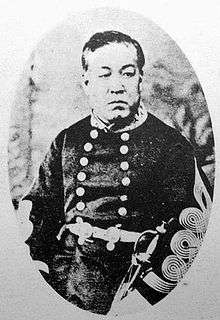Matsumoto Jun (physician)
Matsumoto Jun (松本 順) (also known as Matsumoto Ryōjun 松本 良順) (July 13, 1832 – March 12, 1907) was a Japanese physician who served as the personal physician to the last shōgun, Tokugawa Yoshinobu. He also studied photography with J. L. C. Pompe van Meerdervoort (1829–1908), though he was somewhat unimpressed with his instructor's skills, once describing the result of one of Pompe van Meerdervoort's photographic experiments as "a meagre black shadow". Foreign Minister Hayashi Tadasu was his brother.
Matsumoto Jun 松本順 | |
|---|---|
 Portrait of Matsumoto Jun | |
| Born | July 13, 1832 |
| Died | March 12, 1907 (aged 74) Ōiso, Kanagawa, Japan |
| Nationality | Japanese |
Biography
Matsumoto was born as the son of the domain physician of Sakura Domain, at the clan's Azabu residence in Edo. He was sent to Nagasaki in 1857 to study rangaku, during which time he studied both western medicine and photography. When Swiss photographer Pierre Rossier arrived in Japan in 1859, Matsumoto ordered Maeda Genzō to assist Rossier. Maeda subsequently became a pioneering Japanese photographer. Another link between Matsumoto and photography dates from some point between 1857 and 1859 when he adopted the 13-year-old future photographer Uchida Kuichi.
Matsumoto helped the Aizu Domain modernize its medical practices, and in 1868 moved to Kyoto to assist Aizu daimyō Matsudaira Katamori during the latter's tenure as Kyoto Shugoshoku. The situation in Kyoto was very unsettled, and Matsumoto befriended Shinsengumi leader Kondō Isami and rendered medical assistance to them. During the Second Chōshū expedition of 1866, he served as personal physician to the 14th Tokugawa shōgun, Tokugawa Iemochi.
During the Boshin War of the Meiji Restoration, he volunteered his services as an army medic accompanying the infantry supporting the Shogunate. After the Battle of Aizu in 1868, he made his way to Sendai, and enlisted with the Ōuetsu Reppan Dōmei. Briefly imprisoned after the war by the new Meiji government, he was released through the efforts of Yamagata Aritomo, who asked him to help develop the medical corps of the fledgling Imperial Japanese Army.
During the Meiji era, he maintained his relations with former retainers of the Shogun. He also was instrumental in helping Nagakura Shinpachi and Saitō Hajime build a monument to the Shinsengumi at Itabashi in Tokyo. He subsequently served in the House of Peers and received the title of baron (danshaku) under the Kazoku peerage system. Matsumoto died in 1907, and his grave is at the temple of Myodai-ji in Ōiso, Kanagawa.
References
- Bennett, Terry. Early Japanese Images (Rutland, Vermont: Charles E. Tuttle Company, 1996), 54–56.
- Himeno, Junichi. "Encounters With Foreign Photographers: The Introduction and Spread of Photography in Kyushu". In Reflecting Truth: Japanese Photography in the Nineteenth Century, ed. Nicole Coolidge Rousmaniere, Mikiko Hirayama. (Amsterdam: Hotei Publishing, 2004), pp. 21–22.